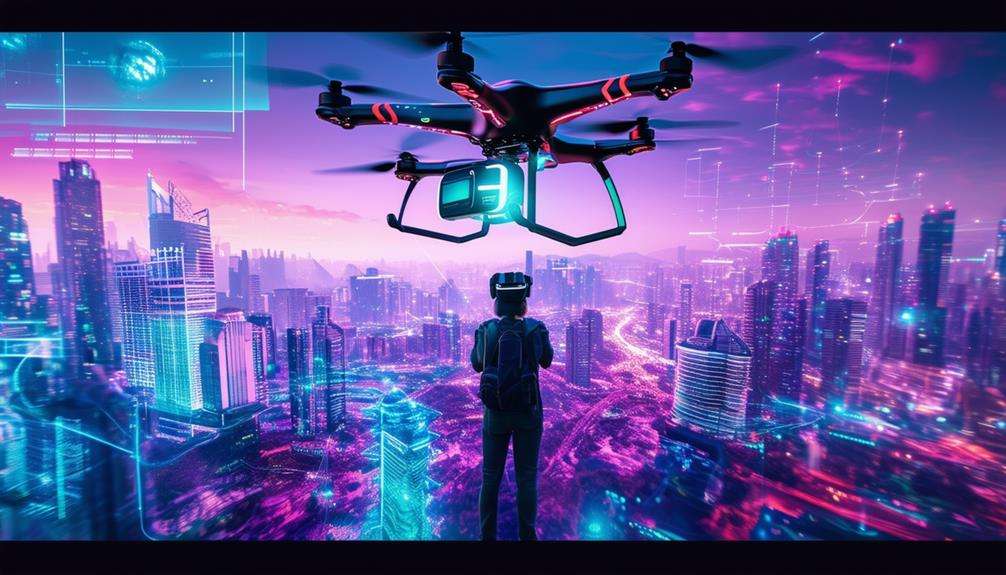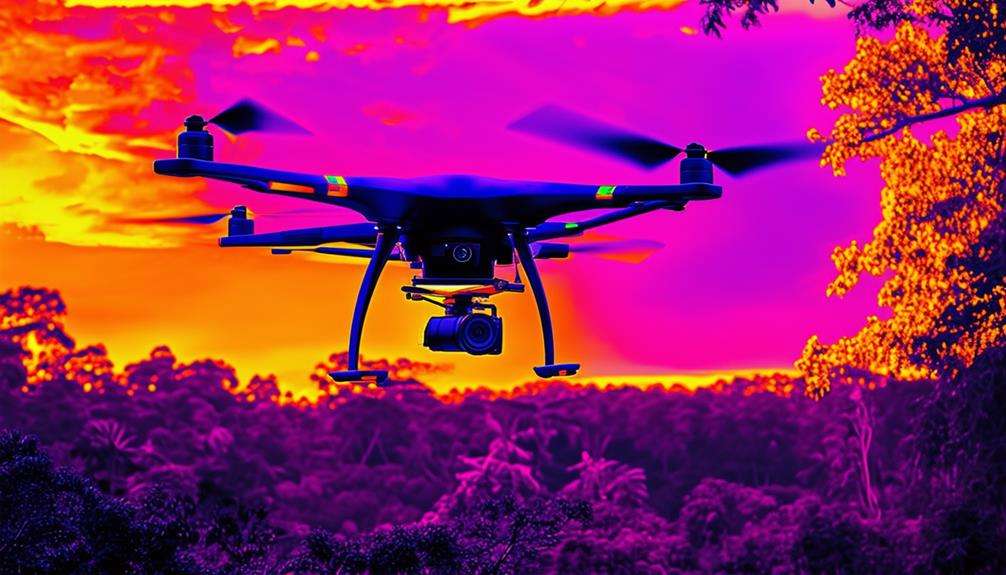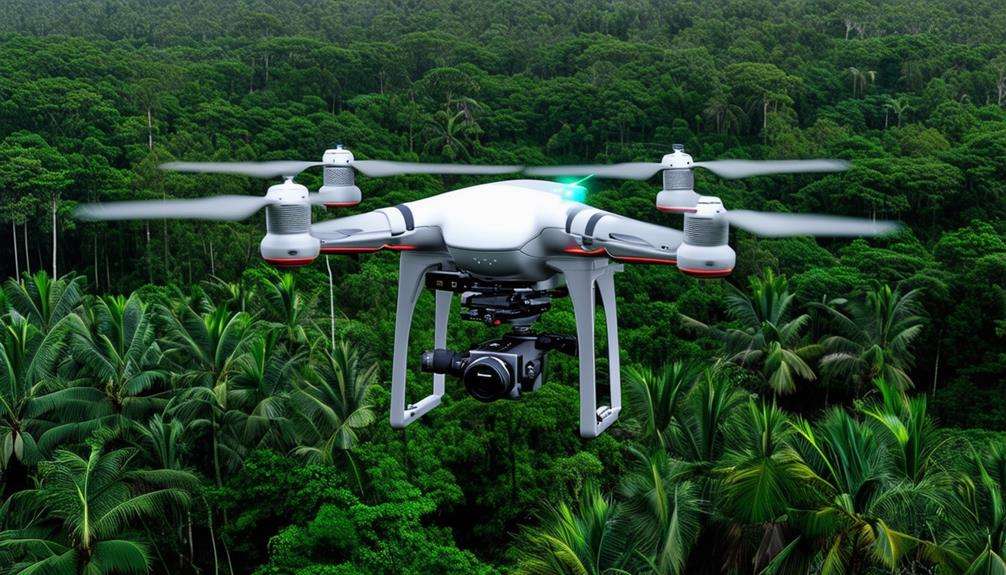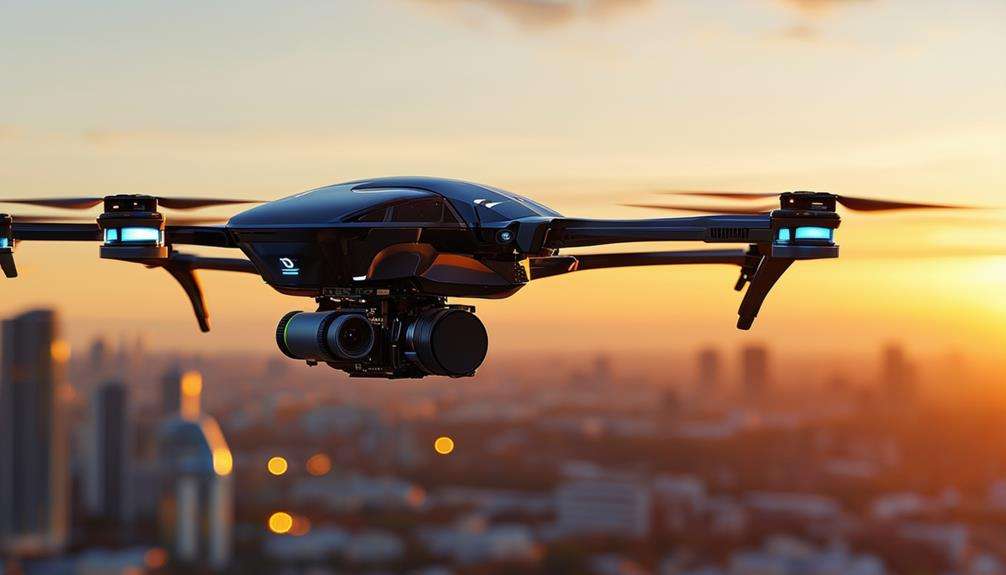The Role of AI in Enhancing Drone Capabilities
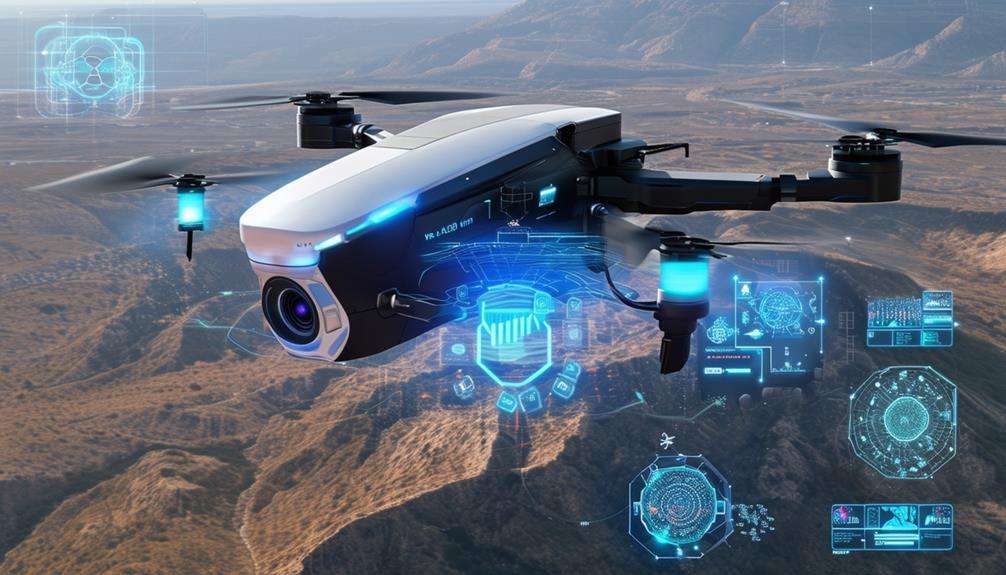
Imagine you're overseeing a fleet of drones capable of navigating complex terrains, avoiding obstacles, and making real-time decisions without human intervention. AI enables this by integrating advanced perception and sensor fusion, allowing drones to interpret their surroundings with remarkable accuracy.
Machine learning further enhances these capabilities through predictive maintenance and swarm intelligence for coordinated movements. However, the ethical implications and potential challenges must also be considered. So, what is the real impact of AI on drone capabilities, and how does it shape their future across various industries?
Perception and Sensor Fusion
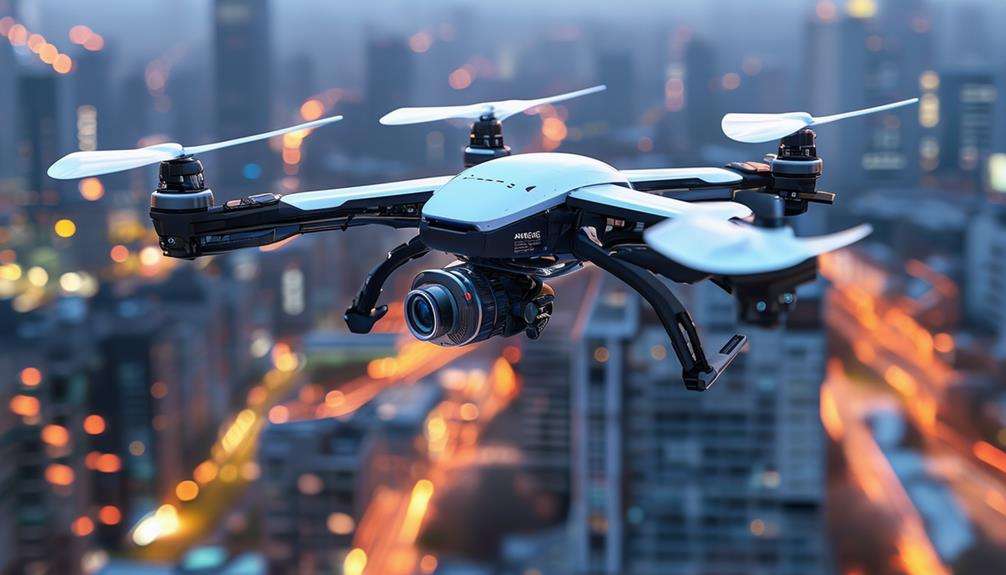
Drones utilize artificial intelligence (AI) to process and integrate data from various sensors, providing the perception required to navigate their surroundings effectively. Perception is crucial for a drone's ability to operate safely and efficiently. AI algorithms are pivotal in analyzing sensor data from sources like cameras, lidar, and GPS. This process, known as sensor fusion, amalgamates these diverse data streams to generate a comprehensive understanding of the environment.
Enhanced situational awareness enables drones to detect and navigate around objects and obstacles, essential for autonomous exploration. They don't merely collect data; they actively interpret it to make real-time decisions. Consider a drone flying through a dynamic environment—it must constantly adapt, avoid collisions, and determine the optimal path forward. Sensor fusion and AI-driven perception empower drones to achieve this high level of responsiveness.
The integration of sensor data ensures precise object detection and obstacle avoidance, allowing drones to make informed decisions. This capability enables drones to traverse complex terrains autonomously, showcasing the significant advancements AI has made in enhancing drone functionalities.
Computer Vision
Computer vision algorithms analyze visual data from cameras and sensors, enabling drones to detect and recognize objects, people, and obstacles in their surroundings. Leveraging AI, these algorithms have evolved to be highly sophisticated, allowing drones to navigate autonomously and avoid collisions during flight. By processing real-time data, drones can make critical split-second decisions essential for their missions.
Equipped with computer vision, drones can perform complex image and video analysis necessary for object detection. This capability allows the drone to identify and track various elements in its environment, whether it's a person, a vehicle, or a tree. Enhanced situational awareness ensures drones operate safely and efficiently.
Real-time data processing is transformative for drones. As they fly, they continuously analyze their surroundings, making informed decisions that enhance their performance and reliability.
This advanced decision-making process distinguishes AI-powered drones from traditional ones. By integrating these advanced technologies, you significantly improve the drone's capabilities, making it more proficient at obstacle avoidance and ensuring mission success.
Autonomous Navigation
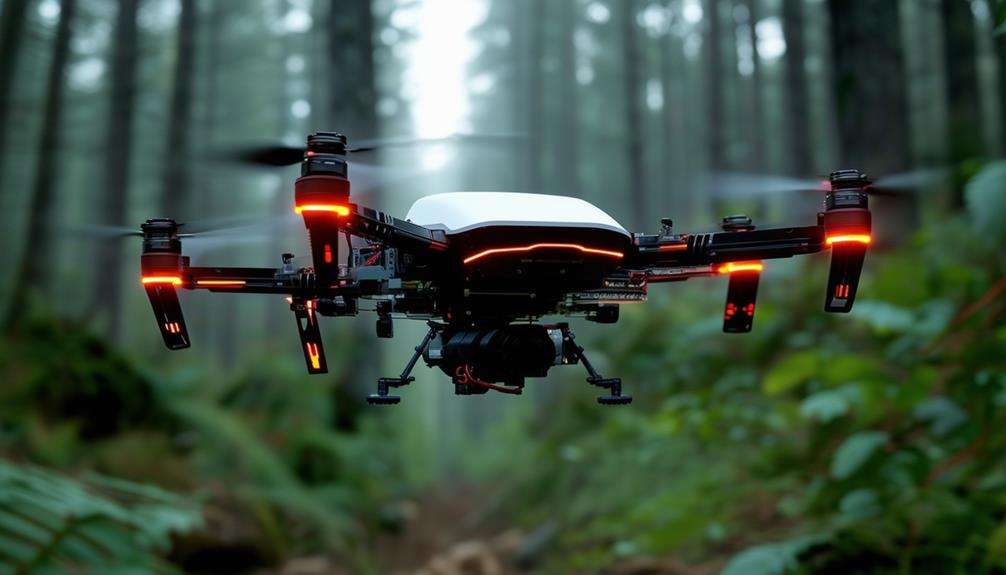
Autonomous navigation, powered by AI, enables drones to seamlessly maneuver through complex environments by processing real-time sensor data. This advanced capability allows AI-driven drones to adapt to changing conditions and obstacles, ensuring they maintain optimal flight paths. Utilizing machine learning algorithms, these drones enhance their decision-making abilities, leading to precise navigation and effective obstacle avoidance.
AI's real-time processing power allows drones to dynamically adjust to new information, rather than merely following pre-planned routes. For instance, a drone navigating a crowded urban area can detect obstacles such as buildings and moving vehicles and instantly recalibrate its path to avoid collisions. This dynamic adaptability makes autonomous navigation both vital and efficient.
Furthermore, AI-powered drones optimize flight paths to conserve time and energy, which is crucial for mission success. Whether delivering packages or conducting search and rescue operations, autonomous navigation significantly enhances drone capabilities.
The real-time adjustments and precise navigation enabled by machine learning algorithms ensure that drones can perform tasks with high efficiency and accuracy, even in the most challenging environments. Thus, with AI at the helm, drones aren't just flying; they're continually thinking and adapting.
Decision-Making Algorithms
Building on sophisticated autonomous navigation capabilities, decision-making algorithms enable drones to analyze real-time data and autonomously adjust their flight paths for optimal performance. These AI-driven algorithms consider multiple factors such as obstacles, weather conditions, and mission objectives. By continuously learning and adapting to changes, they ensure that drones navigate safely and efficiently.
With AI, drones can autonomously make flight decisions, adjusting their flight path, speed, and altitude based on dynamic environmental changes. This capability reduces human intervention and significantly enhances mission success rates. For example, if a drone encounters sudden wind gusts or unexpected obstacles, the AI algorithms will instantly analyze these conditions and make the necessary adjustments, thereby improving drone performance.
Here's a concise overview of how AI decision-making algorithms operate in drones:
| Situation | AI Response |
|---|---|
| Obstacles | Detect and navigate around obstacles |
| Weather Conditions | Adjust flight path and speed |
| Mission Objectives | Optimize route for mission success |
| Dynamic Environmental Changes | Real-time data analysis for adjustments |
| Human Intervention | Minimize to improve efficiency |
This comprehensive approach ensures semantic accuracy, completeness, consistency, conciseness, relevance, interoperability, and trustworthiness in the application of AI decision-making algorithms in drones.
Swarm Intelligence
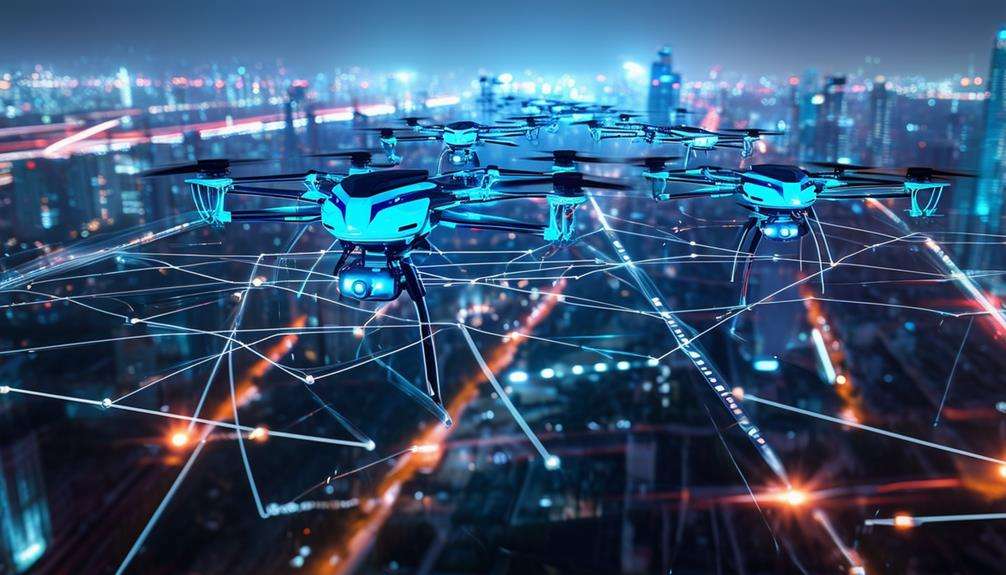
Imagine coordinating multiple drones to move in perfect harmony, efficiently completing complex tasks. With AI-driven swarm intelligence, these drones can make real-time decisions and adapt to their environment as a cohesive unit. This capability transforms operations like disaster response and surveillance, making them more effective, resilient, and adaptive to changing conditions.
Coordinated Drone Movements
Swarm intelligence enables multiple drones to communicate and coordinate their movements in a synchronized manner, significantly enhancing their operational efficiency. Utilizing swarm intelligence, drones can collaborate to achieve shared objectives. AI algorithms are crucial in this setup, allowing drones to adapt to dynamic environments and avoid collisions. This makes coordinated drone movements particularly valuable for critical tasks such as search and rescue missions or surveillance operations.
The benefits of swarm intelligence also include scalability, facilitating the efficient deployment of a large number of drones. This scalability enhances coverage, allowing for more extensive and effective operations. Leveraging AI algorithms, drones in a swarm can adapt to real-time conditions, making them highly versatile.
Here's a quick comparison to illustrate the advantages:
| Aspect | Traditional Drones | Swarm Intelligence Drones |
|---|---|---|
| Coordination | Limited | High |
| Collision Avoidance | Manual | AI-Driven |
| Adaptability to Environment | Low | High |
| Mission Efficiency | Moderate | Enhanced |
Real-Time Decision Making
AI-driven drones make real-time decisions by autonomously sharing information and collaborating, akin to a hive mind. This swarm intelligence enables these drones to work together seamlessly, optimizing task distribution and resource allocation. When faced with dynamic environments, the drones adapt and coordinate efficiently, mimicking collective behaviors seen in nature, such as in ants or birds.
Real-time decision-making enhances mission success rates, allowing drone swarms to tackle complex tasks more effectively. Leveraging AI, these drones continuously share data, adjust strategies, and allocate resources as needed. This capability ensures they can manage intricate operations, from search and rescue missions to agricultural monitoring, with greater accuracy and speed.
In dynamic environments, where conditions are constantly changing, autonomous drones equipped with swarm intelligence can quickly adapt to new information, making split-second decisions that improve overall efficiency and scalability. Their real-time decision-making capabilities ensure even task distribution, preventing any single drone from becoming overwhelmed.
Ultimately, swarm intelligence in drones leads to increased robustness and effectiveness, making them invaluable in various applications. By adopting this technology, you're investing in the future of autonomous systems capable of handling the most demanding challenges.
Machine Learning
Machine learning significantly enhances drone capabilities, especially in predictive maintenance and autonomous navigation. By analyzing data patterns, drones can forecast part failures and navigate complex environments efficiently. This leads to more reliable operations and improved performance, making them indispensable in various sectors.
Predictive Maintenance Algorithms
Harnessing the capabilities of machine learning, predictive maintenance algorithms analyze drone data to anticipate when maintenance is needed. These algorithms meticulously examine sensor data to identify patterns that indicate potential component failures before they occur. By leveraging predictive maintenance, you can streamline maintenance schedules, boosting operational efficiency and minimizing costly downtime.
Machine learning models continuously adapt from new data, enhancing their predictive accuracy over time. Consequently, the more you utilize your drones, the better these algorithms become at forecasting maintenance requirements. This proactive approach ensures that your fleet remains in optimal condition, addressing issues before they escalate.
Here is a comparative overview of predictive maintenance benefits:
| Aspect | Traditional Maintenance | Predictive Maintenance |
|---|---|---|
| Downtime | High | Low |
| Cost Efficiency | Poor | High |
| Maintenance Schedules | Fixed | Optimized |
Autonomous Navigation Systems
Leveraging machine learning, autonomous navigation systems process sensor data to enable drones to make real-time decisions on flight paths. These systems enhance drone autonomy, allowing them to navigate complex terrains and avoid obstacles without human intervention. By utilizing advanced machine learning algorithms, drones can learn from past experiences and adapt to changing environments, significantly improving their real-time adaptation capabilities.
Autonomous navigation systems greatly enhance the efficiency, safety, and accuracy of drones across various applications, particularly in search and rescue missions. When equipped with AI technology, drones can perform tasks independently and intelligently, reducing the need for constant human oversight.
Here are some key benefits of using these advanced systems:
- Increased Efficiency: Drones can optimize their flight paths, saving time and energy.
- Improved Safety: Real-time obstacle detection and navigation prevent collisions and accidents.
- Enhanced Accuracy: Precise data processing leads to better decision-making.
- Critical Search and Rescue Operations: Autonomous drones can quickly locate and assist individuals in emergencies.
Edge Computing
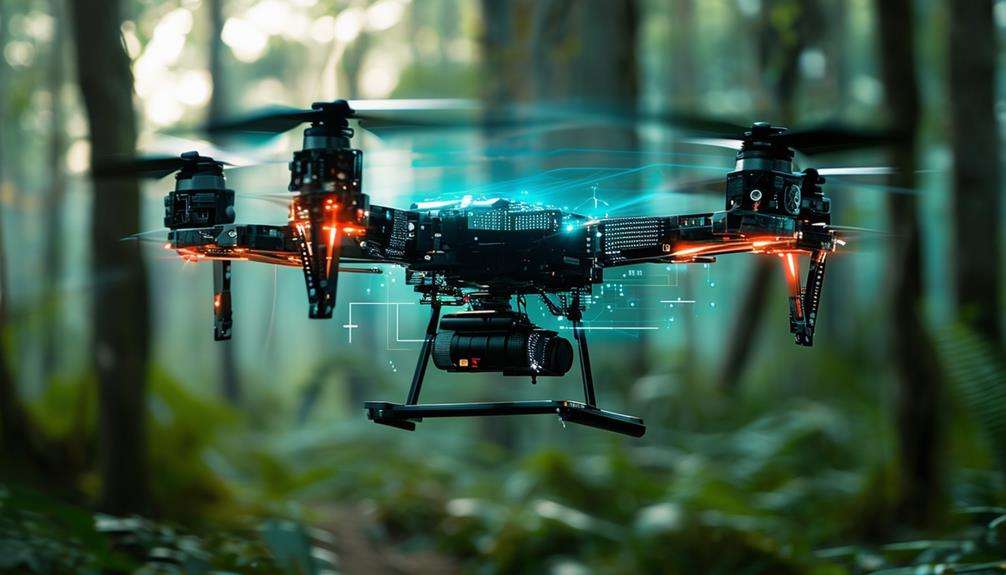
Edge computing enhances drone operations by enabling faster data processing through localized computations, significantly reducing latency. This capability empowers AI-driven drones to perform real-time decision-making and onboard sensor data analysis, thereby bolstering their autonomy and adaptability. This advancement is particularly critical for mission-critical applications where reliability is paramount, such as search and rescue missions.
With edge computing, drones can rapidly analyze images and sensor data, allowing them to execute complex tasks with greater efficiency. This reduces dependency on external networks or cloud services, making AI-powered drones more reliable in challenging environments. Advanced onboard processing systems ensure that drones can autonomously manage a variety of scenarios.
Here's a quick overview of how edge computing enhances drone capabilities:
| Feature | Benefit | Example Usage |
|---|---|---|
| Edge Computing | Faster data processing | Real-time sensor data analysis |
| AI-Powered Drones | Improved autonomy | Autonomous operations |
| Onboard Processing | Reduced latency | Mission-critical applications |
| Real-Time Decision-Making | Enhanced responsiveness | Search and rescue |
| Complex Task Execution | Greater versatility | Diverse challenging environments |
These advancements make drones not only more capable but also more efficient and reliable, broadening their applicability across various fields.
Industry Applications
As drones become more autonomous and responsive due to advancements in edge computing, their applications across various industries have expanded significantly. AI in drone technology is revolutionizing sector operations by enhancing drone autonomy and efficiency.
In agriculture, AI-powered drones are essential for tasks such as crop monitoring, pest detection, and irrigation management. These intelligent drones help farmers optimize yields and manage resources more effectively.
In the construction industry, AI drones conduct site surveys, track progress, and perform safety inspections, ensuring projects adhere to safety standards and timelines. Public safety agencies significantly benefit from AI drones, utilizing them for disaster response, emergency mapping, and situational awareness.
Applications like surveillance and real-time data collection are vital for managing critical incidents. Additionally, AI in military drones has transformed defense operations by offering advanced surveillance, reconnaissance, and tactical support.
- Agriculture: Crop monitoring, pest detection, irrigation management
- Construction: Site surveys, progress tracking, safety inspections
- Public Safety: Disaster response, emergency mapping, situational awareness
- Military: Advanced surveillance, reconnaissance, tactical support
Logistics and delivery companies also leverage AI-enhanced drones for efficient package tracking, route optimization, and last-mile delivery services. Through these diverse applications, AI drones are setting new benchmarks in efficiency and reliability across different industries.
Ethical Considerations
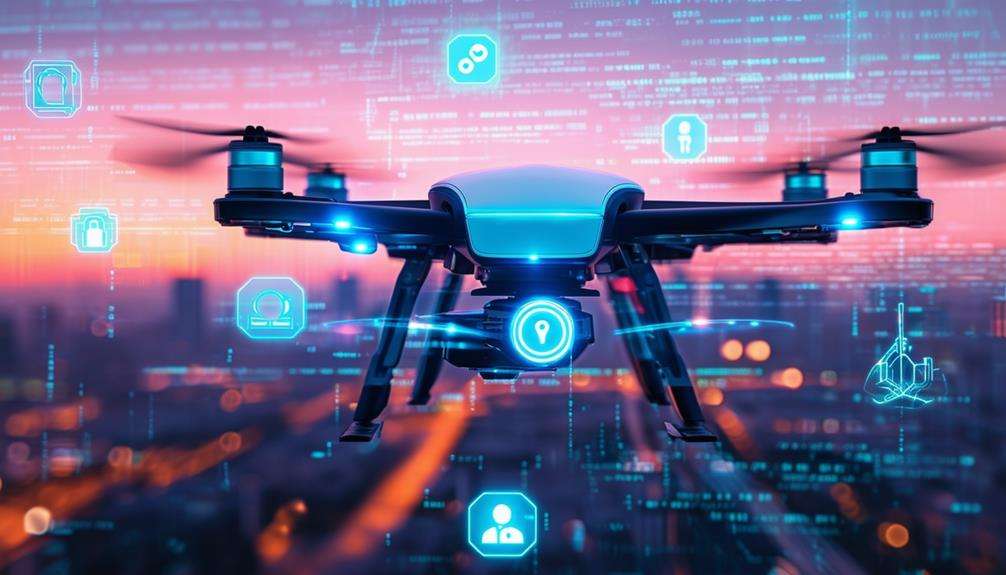
When discussing AI-powered drones, it's crucial to address the ethical implications surrounding their surveillance capabilities and data security. Drones equipped with AI can monitor vast areas, raising significant privacy concerns. These surveillance capabilities can lead to data security risks, especially if the collected data falls into the wrong hands due to breaches or unauthorized access.
Furthermore, the use of AI in drones can result in unfair discrimination due to biased algorithms. These algorithms might make flawed decisions that unfairly target certain groups, increasing the need for accountability in drone operations. Ensuring responsible deployment means carefully considering who's accountable for the drone's actions and decisions.
Autonomy and control issues are also critical. While AI allows drones to operate independently, maintaining human oversight is crucial to prevent potential misuse. Without proper control, autonomous drones could act unpredictably, leading to unintended consequences.
Conclusion
AI significantly enhances drones' capabilities. This improvement is achieved through enhancing their perception, navigation, and decision-making. Utilizing computer vision, machine learning, and edge computing, drones can execute tasks with higher efficiency and precision.
Swarm intelligence enables coordinated movements, further increasing drones' versatility. Despite ethical considerations, AI advancements undeniably elevate drones' operational capabilities across various industries. This leads to innovative and autonomous solutions.

